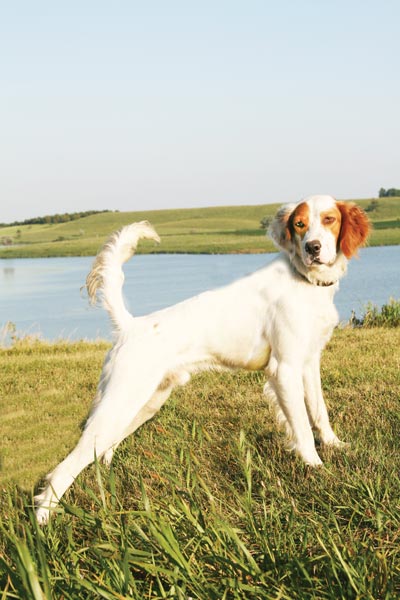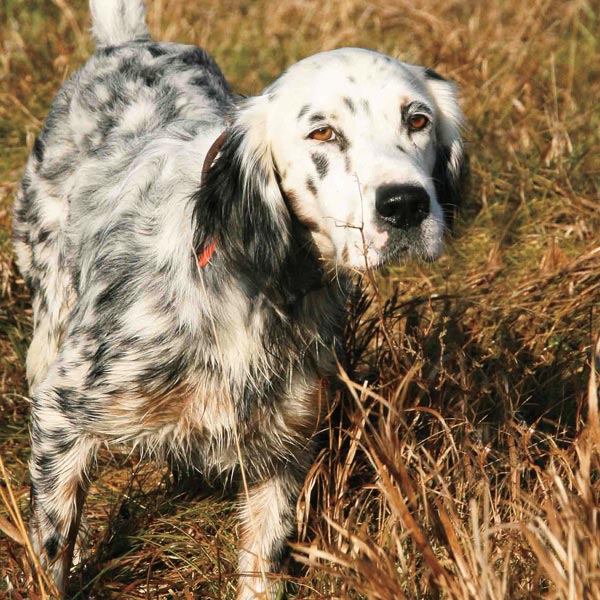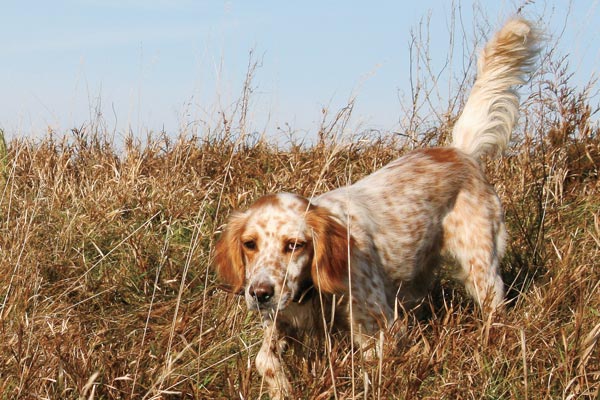When Jill, the 18-month-old English setter, was released in the 20-acre hayfield, the 45-pound white, orange and black dog took off like she was on fire. In just a few minutes, Jill covered most of the 20 acres so fast and with such fury that finding a bird seemed unlikely, maybe even impossible.
Then, way down in the furthest corner of the cover she slammed into a solid motionless point—something like an English setter from a classic painting or famous sculpture or a well-done photograph.
Anyone watching this gun dog at work would quickly understand why this breed has been, still is, and will be so popular with hunters who appreciate high style combined with an intense bird finding ability on anything from ruffed grouse and woodcock to prairie grouse, all species of quail, and, of course, ringneck pheasants.
The reason for this breed's popularity is evident. Field trialers, hunt testers and hunting competitors have all added to the development of the English setter to make the breed into the easily recognized and much respected dog we see today in North America, Europe, and throughout the world.
Anyone interested in owning an English setter needs to understand, however, that there are many types and lines of this breed, ranging from 75-pound show dog beauties that might have trouble hunting for their food dish to 45-pound gun dogs in a compact package bred to hunt all species of gamebirds and, like Jill, do so at a sizzling pace.
How to Hunt
"Five friends and I hunt our English setters on ruffed grouse and woodcock at least 30 days each season here in Michigan and on road trips from Maine to Minnesota with occasional trips into Canada," says Roger Henderson, who lives in Lansing, Michigan.
 "
"
We have a line of English setters we've developed for more than 35 years by breeding the dogs we hunt with and occasionally crossing out to other proven hunters that have lots of prey drive, speed and cooperation. We like dogs that range out but regularly check in with us to see where the guns are going," Henderson says.
"Yes, we use e-collars with beeper locations and electric collars with GPS locators as insurance policies to keep track of some dogs when on point or when they might get out too far and get lost in thick cover," Henderson adds as a suggestion to anyone hunting anywhere far from home. "Even our oldest setters get disoriented sometimes and any electronics that help find them can keep a good hunt from turning into a disaster."
On the subject of keeping track of dogs in the field, Don Allen from Gainesville, Florida, says, "I've used English setters and English pointers to hunt bobwhites in nine states from Florida and Alabama to Texas and Oklahoma over 50 years. Though I like both breeds of dogs, the English setters tend to be easier to handle because they're team players that stay closer to me when we hunt. The English pointers run further and find lots of birds way off in the distance so we have to spend lots of time looking for them.
"The setters cover the ground up close for birds that the pointers might over-run and miss. So, in the end the setters seem to produce as many quail as the pointers do," Allen adds. "And they do so with less effort and more comfort for shotgunners."
Wicker Bill Crist, a professional gamebird hunting guide from Pierre, South Dakota, uses his English setters with clients for combination hunts for pheasants and sharptails. "My setters automatically adjust to the different birds even when they're in the same pasture, hay lands, crop fields, and ravines," Crist says.
"When working pheasants in corn or sorghum or tracking them up and down mile-long gullies, my dogs shorten up their range and wait for the guys with guns to catch up with them. Likewise, when searching for grouse out in a five-mile wide hayfield, the etters will run wide, fast, and far, then, when they find grouse, they'll stay back and wait for my hunters to get there," Crist says.
English setters, in Crist's experience, are a breed of gun dog good at learning these different requirements for hunting different gamebirds.
"We use our English setters to hunt desert quail," says Carol Ann Smith from Tucson, Arizona. "And we often go with friends who use English pointers and German shorthairs. The English pointers tend to range out far and wide, sometimes on the edge of getting out of sight while the German shorthairs usually stay in real close, almost underfoot at times," Smith says.
"Our setters hunt at distances pretty much between these other breeds and cover as much ground as the others do. People without their own dogs who hunt with us say that our dogs produce more birds than these other breeds on the average.
"There is a problem for our setters in desert heat, but that issue is resolved by clipping their coats," Smith adds. "And in some places we hunt, there are sharp rocks and cactus that bother our dogs' feet, but nylon and leather boots take care of this problem in most cases."
Versatile Breed
For 40-plus years, Frank Spaeth and his wife, Nancy, have raised, trained and hunted their own line of English setters. As a long-time member of and judge in the North American Versatile Hunting Dog Association (NAVHDA), Spaeth trains and hunts his English setters as versatile gun dogs with a couple of them earning the title of Versatile Champion.

"My setters will retrieve ducks and geese on land and out of water, though we use our dogs to mainly hunt ruffed grouse and woodcock because these birds are in our backyard where we live in northern Minnesota," Frank says. "In breeding our line of setters, we select for good nose, great desire and strong cooperation.
"Most all our dogs have the typical genial English setter temperament so we can have three or four living with us in the house at the same time. We also test all our breeding stock for hip dysplasia and other genetic issues. In addition, we select for standard size and conformation so we have dogs that look like typical English setters. Pups are available on occasion.
"Though all our dogs are versatile hunters, the males are easier to handle and better team players," he notes. "The females tend to range further and, in the woods, always wear bells, beepers, and GPS collars so we can find them when on point.
"All our brood stock dogs are instinctively good retrievers, but we force-fetch them just like they were field trial Labradors to ensure that they will pick up and bring to hand any gamebird we shoot."
Proper Lines
"Yeah, I guess I could be called a 'backyard breeder' because I have no big-time famous kennel or big winners in field trials," says Vern Austin, an English setter owner, breeder and hunter from Decatur, Arkansas. "Along with my friends and family, I have raised my line of setters for 50 years using whatever dogs we thought would make good bird hunters.
"If I think we need more speed and range, I'll bring in some field trial stock. Or if I want more cooperation and close-in dog work, I'll bring in Llewellin lines," Austin explains as an example of his breeding policy.
"Our method for testing over dogs is to hunt them a lot and watch each one for signs of a good nose and intense prey drive as well as natural point, quartering, backing and retrieving," Austin emphasizes. "We hunt all over, 30 to 40 days each year on quail in Arkansas, Missouri, Kansas, and Texas, and on pheasants and prairie grouse in South Dakota. We also sometimes run a few select dogs in hunting contests as another way to prove their potential in our breeding program.
"Do we always have pups available for sale? No, with our line of English setters, we only breed 'em when we need 'em," Austin says. "We're not in breeding to make money but instead to make good gun dogs."
"More than 85 percent of my English setters have been real natural retrievers out of the dozens of dogs in the line I have had for more than 50 years," Austin continues. "I've bred for retrieve and I train for retrieve starting when pups are six weeks old. Some youngsters are better than others early on, but by the time they're a year old most all of them will fetch any bird we shoot on land and in water."
Peter Maffai of Willow Lake, South Dakota, is a proponent of force-fetching. "All my English setters are sent to a full-time professional trainer for a complete 'force fetching' program lasting several weeks," he says. "I want guaranteed retrievers on prairie grouse on the grasslands in the western part of the state and on pheasants and ducks here around home.
"My trainer uses the same 'trained retrieve' method on setters that he does for Labradors, so when my dogs are finished they will bring back any gamebird we hunt."
What about the belief that English setters are slow-starters? "Some people say that English setters are not early bloomers or easy to train under a year of age," says Chuck Wilson from Waco, Texas. "I have found this to be a misconception, especially with my line of Llewellin setters.
"We start all our pups at seven weeks with basic obedience and yard work. We then progress through introduction to guns and gamebirds, so that our young dogs are ready for their first hunting season when they are still under 1 year old. They perform like most other breeds of gun dogs and just need exposure and experience early on to turn into good hunters as they get older."
Ed Erickson from Autumn Breeze Training Kennel in Isle, Minnesota, agrees.
"I guess there are some lines of English setters that might be slow to mature, but most all the young English setters that I have trained in the past 35 years have acted like other breeds of pointing dogs," Erickson says.
"I treat English setters like any other kind of versatile gun dog and expect them to hunt and retrieve all upland gamebirds as well as fetch wounded and dead ducks and geese on land and in water. There's no reason I can see to wait for so-called later maturity to begin this standard training program."
Pup Prospects
Finding English setter puppies for sale and trainers for adult English setter gun dogs is fairly easy just by looking on the Internet or checking the classified ad section of any GUN DOG magazine.
For example, High Fly'n Kennels owned and operated by Greg and Carla Fryar in Elko, Minnesota, almost always has available new litters of Llewellin setters from parents that have won in Shoot to Retrieve contests, have Master Hunter titles in AKC Hunt tests, and have top titles in National Llewellin Gun Dog Club Championship Field Trials. You can reach them at: 612-840-8013.
The Decoverly line of English setters is the main focus for Bill Sordini at Decoverly Kennels in Falls, Pennsylvania, where Sordini breeds and trains his own and customers' dogs year round. The Decoverly setter, distinctive for natural ability and desire, is also famous for good temperament and "classic" setter good looks. Reach them at: 570-378-3357 or 570-592-4300.
In addition to breeding and training his personal line of English setters for customers, Jim Gourley, in Beverly, Kansas, offers wild quail hunts close to his home in the north-central part of the state. Using his own and customers' English setters, Gourley hunts bobwhites from early November to the end of January. Customers say this is a great way to have a setter trained by Gourley then proven in the field. Reach him at: 785-249-4316.
Little River Kennels, owned and operated by George Gubitose, is located in the lake region of New Hampshire where Gubitose produces four or five litters of Llewellin setter pups each year. All the parents are registered in the American Field dog Stud Books and are DNA tested. Call them at: 603-875-8804







